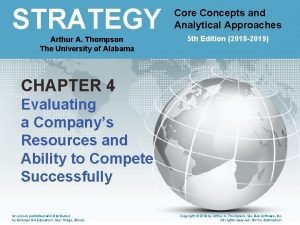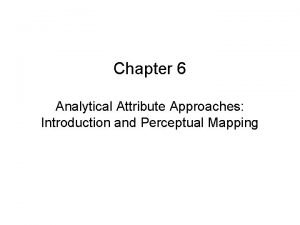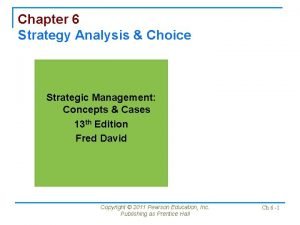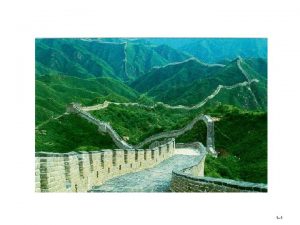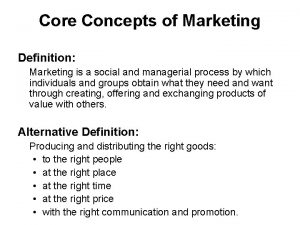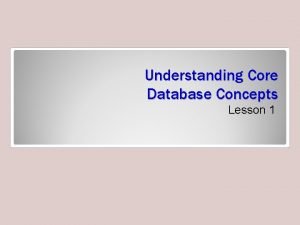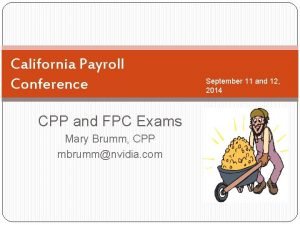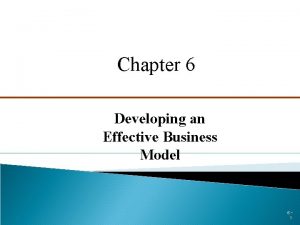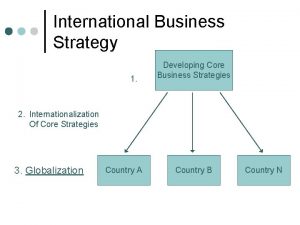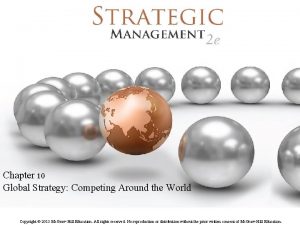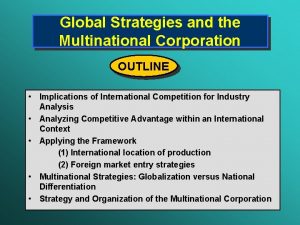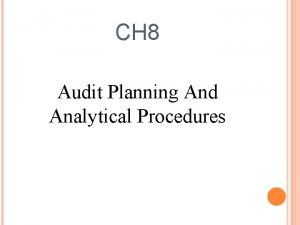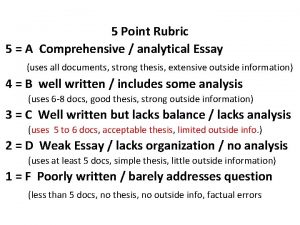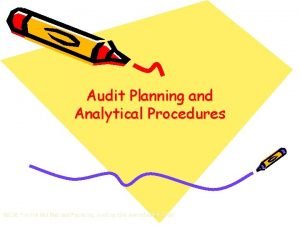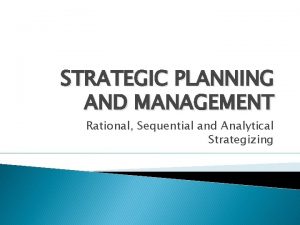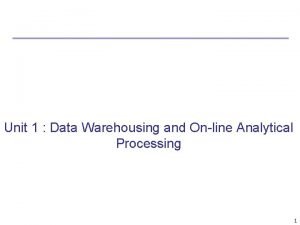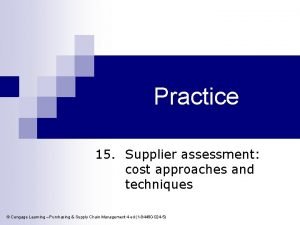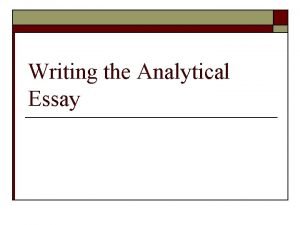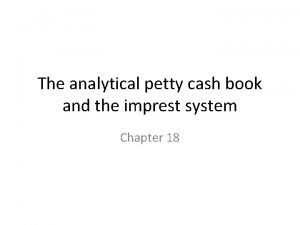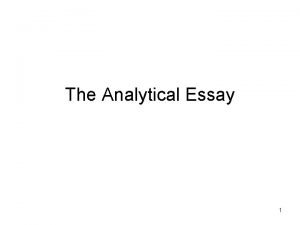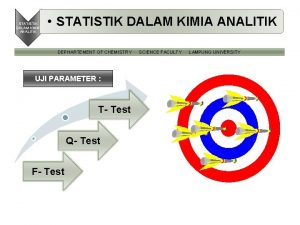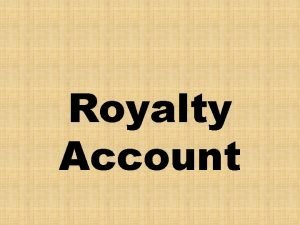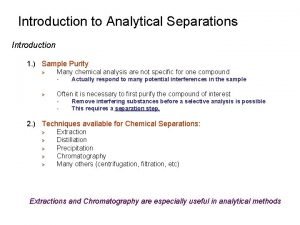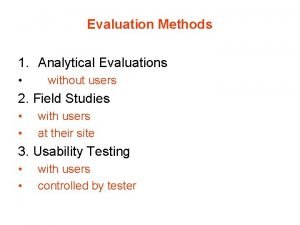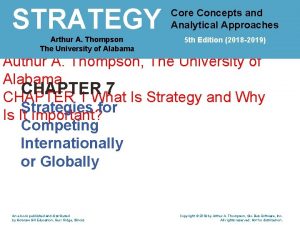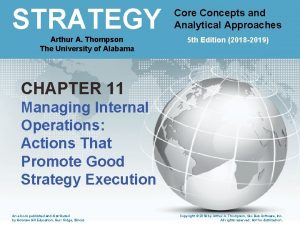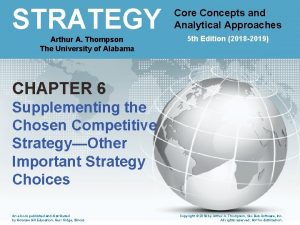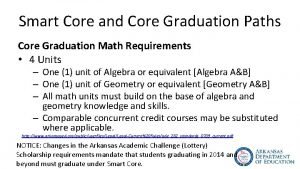STRATEGY Core Concepts and Approaches Concepts Analytical and

































































































- Slides: 97

STRATEGY Core Concepts and Approaches Concepts. Analytical and Analytic Strategy – Core 5 th Edition (2018 -2019) Arthur A. Thompson Approaches 5 e The University of Alabama Authur A. Thompson, The University of Alabama CHAPTER 3 CHAPTER 1 What Is Strategy and Why Evaluating Is Ita Important? Company’s External Environment An e-book published and distributed by Mc. Graw Hill Education, Burr Ridge, Illinois Copyright © 2018 by Arthur A. Thompson, Glo-Bus Software, Inc. All rights reserved. Not for distribution.

Analysis is the critical starting point of strategic thinking. Kenichi Ohmae, consultant and author Copyright © 2018 by Glo-Bus Software, Inc. 3– 2

Things are always different— the art is figuring out which differences matter. Laszlo Birinyi, investments manager Copyright © 2018 by Glo-Bus Software, Inc. 3– 3

In essence, the job of a strategist is to understand cope with competition. Michael E. Porter, Harvard Business School professor Copyright © 2018 by Glo-Bus Software, Inc. 3– 4

No matter what it takes, the goal of strategy is to beat the competition Kenichi Ohmae, consultant and author Copyright © 2018 by Glo-Bus Software, Inc. 3– 5

Learning Objectives 1. To gain command of the basic concepts and analytical tools widely used to diagnose a company’s industry and competitive conditions. 2. To become adept in recognizing the factors that cause competition in an industry to be fierce, more or less normal, or relatively weak. 3. To learn how to determine whether an industry’s outlook presents a firm with sufficiently attractive opportunities for growth and profitability. 4. To understand why in-depth evaluation of specific industry and competitive conditions is a prerequisite to crafting a strategy well matched to a firm’s situation. Copyright © 2018 by Glo-Bus Software, Inc. 3– 6

Chapter 3 Roadmap § The Strategically Relevant Factors Influencing a Company’s § External Environment Assessing a Company’s Industry and Competitive Environment ► Question 1: What Competitive Forces Do Industry Members Face, and How Strong Are They? ► Question 2: What Forces Are Driving Changes in the Industry and What Impacts Will They Have on Competitive Intensity and Industry Profitability? ► Question 3: What Market Positions Do Rivals Occupy—Who Is Strongly Positioned and Who Is Not? ► Question 4: What Strategic Moves Are Rivals Likely to Make Next? ► Question 5: What Are Key Factors for Future Competitive Success? ► Question 6: Is the Industry Outlook Conducive to Good Profitability? Copyright © 2018 by Glo-Bus Software, Inc. 3– 7

Understanding a Company’s Situation § Actions to steer a firm in a different direction or alter its strategy must be predicated on deep understanding of two facets of its situation: 1. The industry and competitive environment in which the firm operates and the forces acting to reshape this environment 2. The firm’s own market position and competitiveness • Its resources and capabilities • Its strengths and weaknesses vis-à-vis rivals • Its windows of opportunity Copyright © 2018 by Glo-Bus Software, Inc. 3– 8

Figure 3. 1 From Thinking Strategically about the Company’s Situation to Choosing a Strategy Copyright © 2018 by Glo-Bus Software, Inc. 3– 9

The Strategically Relevant Factors Influencing a Firm’s External Environment § External factors and influences in the “macroenvironment” that influence a firm’s decisions about its direction, objectives, strategy, and business model include: ► General economic conditions ► Political, regulatory, and legal influences ► Technological influences ► Sociocultural forces (values, lifestyles, and shifting population demographics) ► Considerations Copyright © 2018 by Glo-Bus Software, Inc. relating to the natural environment 3– 10

FIGURE 3. 2 The Components of a Company’s Macroenvironment Copyright © 2018 by Glo-Bus Software, Inc. 3– 11

Assessing a Company’s Industry and Competitive Environment There are six questions that must be asked answered: 1. What competitive forces do industry members face, and how strong are they? 2. What forces are driving changes in the industry, and what impact will these changes have on competitive intensity and industry profitability? 3. What market positions do industry rivals occupy—who is strongly positioned and who is not? 4. What strategic moves are rivals likely to make next? 5. What are the key factors for future competitive success? 6. Is the industry outlook conducive to good profitability? Copyright © 2018 by Glo-Bus Software, Inc. 3– 12

Question 1: What Competitive Forces Do Industry Members Face? The state of competition in an industry is a composite of five competitive forces: 1. The market maneuvering and jockeying for buyer patronage among rival sellers in the industry 2. The threat of new entrants into the market 3. The attempts of companies in other industries to win buyers over to their own substitute products 4. The exercise of supplier bargaining power 5. The exercise of buyer (or customer) bargaining power Copyright © 2018 by Glo-Bus Software, Inc. 3– 13

FIGURE 3. 3 The Five-Forces Model of Competition: A Key Analytical Tool Copyright © 2018 by Glo-Bus Software, Inc. 3– 14

How to Analyze the Five Competitive Forces Step 1 Identify the specific competitive pressures associated with each of the five forces. Step 2 Evaluate how strong the pressures comprising each of the five forces are (fierce, strong, moderate to normal, or weak). Step 3 Determine whether the collective strength of the five competitive forces is conducive to earning attractive profits. Copyright © 2018 by Glo-Bus Software, Inc. 3– 15

Core Concept Competitive maneuvering among industry rivals is ever-changing, as competing sellers initiate round after round of offensive and defensive moves, emphasizing first one mix of competitive weapons and then another in efforts to improve their market positions and profitability. The ongoing maneuvers and jockeying for position create a continually evolving competitive landscape where the market battle ebbs and flows, sometimes takes unpredictable twists and turns, and produces winners and losers. Copyright © 2018 by Glo-Bus Software, Inc. 3– 16

Competitive Pressures Created by the Rivalry among Competing Sellers § A market is a competitive battlefield where the contest among industry rivals is ongoing and dynamic. ► Each rival is motivated to use whatever “weapons” in its business arsenal will attract and retain buyers, strengthen its market position, and yield good profits. ► The challenge is to craft a competitive strategy that at the very least allows a firm to hold its own against rivals and, more ideally, strengthens its ability to compete successfully enough to produce a competitive edge over rivals. Copyright © 2018 by Glo-Bus Software, Inc. 3– 17

Why Rivalry Is Usually the Strongest of the Five Competitive Forces § When one competitor deploys a strategy or makes a new strategic move that produces good results, its rivals must respond with offensive or defensive countermoves calculated to preserve their market standing and avoid lower profitability. § This pattern of move and countermove, attack and defend, adjust and readjust makes the competitive battle among rivals dynamic and fluid, with firms gaining or losing ground in the marketplace according to whether their strategic maneuvers succeed or fail. § The winners—current market leaders—have no guarantees of continued leadership; their market success is only as durable as the power of their strategies to fend off the strategies of ambitious challengers All this constant maneuvering and jockeying quite often results in the competitive battle among industry rivals being the strongest of the five competitive forces. Copyright © 2018 by Glo-Bus Software, Inc. 3– 18

FIGURE 3. 4 The “Weapons” That Can Be Used to Battle Rivals • Reducing prices; granting special • Building a bigger/better dealer discounts to win the business of network particular buyers • Offering low interest rate • Introducing more or different financing features • Offering coupons • Innovating to improve product performance or quality • Improving customer service • Running ads to inform buyers of new or special features and/or to strengthen brand awareness or brand image • Improving warranties • Having periodic sales promotions, holding clearance sales, advertising items on sale • Improving selection of models and styles Copyright © 2018 by Glo-Bus Software, Inc. • Allowing buyers to customize what they buy • Providing quicker or cheaper delivery • Developing competitively valuable capabilities rivals don’t have 3– 19

FIGURE 3. 4 The Factors Affecting the Strength of Rivalry Copyright © 2018 by Glo-Bus Software, Inc. 3– 20

What Causes Rivalry to Become Stronger? § Rivalry is more intense when: ► Competing sellers are active in making fresh moves to improve their market standing and business performance. ► Buyer demand is growing slowly. ► Buyers incur low costs in switching to rival brands. ► The products of rival sellers are essentially identical or else weakly differentiated, resulting in little or no buyer brand loyalty. ► Sellers have idle capacity and/or excess inventory. ► The industry’s product is costly to hold in inventory, perishable, or seasonal. Copyright © 2018 by Glo-Bus Software, Inc. 3– 21

What Causes Rivalry to Become Stronger? (continued) § Rivalry is more intense when: ► The number of rivals increases and/or rivals are of roughly equal size and competitive capability. ► One or more rivals are dissatisfied with their business performance and are making aggressive moves to attract more customers. ► Outsiders have recently acquired weak competitors and are spending heavily to turn them into major contenders. ► Rivals have diverse industry outlooks, objectives, or strategies and/or have production facilities in countries where production costs are materially different. Copyright © 2018 by Glo-Bus Software, Inc. 3– 22

What Causes Rivalry to Become Weaker? § Rivalry tends to be less intense when: ► Industry members infrequently launch aggressive actions to take sales and market share away from rivals ► Buyer demand is growing rapidly ► The products of rival sellers are strongly differentiated and the loyalty of buyers to their preferred brand is high ► Buyer costs to switch to rival brands are high ► Industry rivals are so numerous that any one firm’s attempt to grow its business has little direct impact on rival businesses and thus provokes little need for retaliation Copyright © 2018 by Glo-Bus Software, Inc. 3– 23

What Causes Rivalry to Become Weaker? (continued) § Rivalry tends to be less intense when: ► Sellers ► Rivals have small inventories and/or little idle capacity have low fixed costs and low inventory storage costs ►A few large sellers have the majority of sales and dominant market shares ► Rivals have similar costs and similar industry outlooks— there are no industry mavericks to disrupt the status quo Copyright © 2018 by Glo-Bus Software, Inc. 3– 24

Characterizing Industry Rivalry Cutthroat or Brutal When competitors engage in protracted price wars or habitually undertake other aggressive strategic moves that prove mutually destructive to profitability, causing many/most industry members to lose money Fierce to Strong When the battle for market share is so vigorous that the profit margins of most industry members are squeezed to sub-par or even bare-bones levels Moderate or Normal When the maneuvering among industry members, while lively and healthy, still allows most industry members to earn acceptable profits Weak When most industry firms are relatively well satisfied with their sales growth and market shares, rarely undertake offensives to steal customers away from one another, and— because of weak competitive forces—earn consistently good profits and returns on investment Copyright © 2018 by Glo-Bus Software, Inc. 3– 25

Competitive Pressures Associated with the Threat of Potential Entry The increase in competitive pressures faced by industry members due to the threat of market entry of new firms depends on: § Whether the barriers to successfully entering the industry are high or low § The size of the pool of entry candidates and the resources at their command to hurdle the entry barriers § The expected reaction of existing industry members to the entry of newcomers § How attractive the industry’s growth and profit prospects are to potential entrants Copyright © 2018 by Glo-Bus Software, Inc. 3– 26

Common Barriers to Entry § Cost advantages held by industry incumbents § Strong brand preferences and high degrees of customer loyalty to the brands they are currently purchasing § High capital requirements § The difficulties of building a network of distributors or retailers and securing space on retailers’ shelves § Restrictive or costly regulatory policies that limit/bar new entrants § Tariffs and international trade restrictions § The likelihood that industry incumbents will strongly resist entrants’ efforts to secure a profitable volume of sales Copyright © 2018 by Glo-Bus Software, Inc. 3– 27

The Cost Advantages of Incumbents: An Important Entry Barrier Current industry members may have cost advantages that a new entrant cannot easily overcome: 1. Scale economies in production, distribution, or other activities 2. Learning-based costs savings that accrue from in-industry experience in performing certain activities such as manufacturing or new product development or inventory management 3. Cost-savings accruing from patents or proprietary technology 4. Partnerships with the best and cheapest suppliers of raw materials and components 5. Favorable locations 6. Low fixed costs (because incumbents have older facilities that have been mostly depreciated) Copyright © 2018 by Glo-Bus Software, Inc. 3– 28

FIGURE 3. 5 Factors Affecting the Threat of Entry Copyright © 2018 by Glo-Bus Software, Inc. 3– 29

Competitive Pressures Associated with the Threat of New Entrants § Entry threats are stronger when: ► The pool of entry candidates is large and some have resources that make them strong market contenders ► Entry barriers are low or can be easily hurdled by entry candidates ► Industry members can expand their presence into other product segments or geographic areas ► Newcomers ► Buyer can expect to earn attractive profits demand is growing rapidly ► Industry members are unable (or unwilling) to strongly contest the entry of new firms Copyright © 2018 by Glo-Bus Software, Inc. 3– 30

Core Concept The threat of entry is stronger § § when entry barriers are low, when incumbent firms are unable or unwilling to vigorously contest a newcomer’s entry, when there’s a sizable pool of entry candidates, and when the industry’s outlook is highly attractive to outsiders. Copyright © 2018 by Glo-Bus Software, Inc. 3– 31

When Is the Threat of Entry Weaker? § Entry threats are weaker when: ► The pool of entry candidates is small ► Entry barriers are high ► Existing competitors are struggling to earn good profits ► The industry’s outlook is risky or uncertain ► Buyer demand is growing slowly or is stagnant ► Industry members will strongly contest the efforts of new entrants to gain a market foothold Copyright © 2018 by Glo-Bus Software, Inc. 3– 32

The Best Test of Whether the Entry of New Competitors Is Likely Are the industry’s growth and profit prospects strongly attractive to potential entry candidates? A “Yes” answer = Threat of potential entry is a strong competitive force A “No” answer = Threat of potential entry is a weak competitive force Copyright © 2018 by Glo-Bus Software, Inc. 3– 33

When the Threat of Entry Is Certain to Be High § Rapidly growing market demand high potential profits act as magnets, growing the pool of entry candidates and motivating potential entrants (most usually including resource-rich companies capable of becoming formidable competitors!!!) to commit the resources needed to hurdle entry barriers—in which case the high probability of new entry qualifies as a strong competitive force. Copyright © 2018 by Glo-Bus Software, Inc. 3– 34

Competitive Pressures from the Sellers of Substitute Products § Companies in one industry come under competitive pressure from the actions of companies in a closely adjoining industry whenever buyers view the products of the two industries as good substitutes § Examples of substitutes ► Attending movies at theaters versus subscribing to Netflix ► Cell phone cameras versus traditional digital cameras ► Beer versus wine versus hard liquors ► Contact lens versus prescription glasses Copyright © 2018 by Glo-Bus Software, Inc. 3– 35

FIGURE 3. 6 Factors Affecting Competition from Substitute Products Copyright © 2018 by Glo-Bus Software, Inc. 3– 36

When Are Substitute Products a Strong Competitive Force? § The strength of competitive pressures from substitute products depends on: ► Whether substitutes are readily available and attractively priced ► Whether buyers view substitutes as being comparable or better in term of attributes ► How much it costs buyers to switch to substitutes Rule Copyright © 2018 by Glo-Bus Software, Inc. The lower the price of substitutes, the higher their quality and performance, and the lower the user’s switching costs, the more intense the competitive pressures posed by substitute products. 3– 37

When Is Competition from Substitutes Stronger? § Competitive pressures from substitutes are stronger when: ► Substitutes are readily available and attractively priced ► Substitutes are of comparable or better quality and have desirable performance features ► Buyers incur low costs in switching to substitutes ► Buyers are growing more comfortable with using substitutes Copyright © 2018 by Glo-Bus Software, Inc. 3– 38

When Is Competition from Substitutes Weaker? § Competitive pressures from substitutes are weaker when: ► Good substitutes are not readily available or don’t exist ► Substitutes are higher priced relative to the value they deliver to buyers ► Substitutes lack comparable or better performance features ► Buyers have high costs in switching to substitutes Copyright © 2018 by Glo-Bus Software, Inc. 3– 39

Three Signs that Substitute Products Are a Strong Competitive Force 1. Sales of substitutes are growing faster than overall sales of the industry in question ► An indication that the sellers of substitutes are stealing the industry’s customers away 2. The producers of substitute products are investing in added production capacity and expanding their market coverage 3. Profits of the producers of substitutes are rising Copyright © 2018 by Glo-Bus Software, Inc. 3– 40

Competitive Pressures Stemming from the Bargaining Power of Suppliers § Whether the suppliers of industry members represent a strong, moderate, or weak competitive force depends on how much bargaining power suppliers have to influence the terms and conditions of supply in their favor. Powerful or influential suppliers can be a source of strong competitive pressure when they have the ability to charge industry members higher prices and/or make it difficult or more costly for industry members to switch to other suppliers. Copyright © 2018 by Glo-Bus Software, Inc. 3– 41

FIGURE 3. 7 Factors Affecting the Bargaining Power of Suppliers Copyright © 2018 by Glo-Bus Software, Inc. 3– 42

Factors Affecting Whether the Bargaining Power of Suppliers Is Strong or Weak § Whether the item that industry members are purchasing from suppliers is in short supply or whether ample quantities are readily available from any of several suppliers § Whether certain suppliers provide a differentiated input that enhances the performance or quality of the industry’s product § Whether certain suppliers provide equipment or services that deliver valuable cost-saving efficiencies to industry members in operating their production processes § Whether the item being supplied a standardized commodity readily available from many suppliers at the going market price § Whether industry members easily switch their purchases from one supplier to another or switch to substitute inputs Copyright © 2018 by Glo-Bus Software, Inc. 3– 43

Factors Affecting Whether the Bargaining Power of Suppliers Is Strong or Weak (cont’d) § Whether suppliers provide an item that accounts for a sizable fraction of the costs of the industry’s product § § Whether industry members are major customers of suppliers § Whether it makes economic sense for industry members to integrate backward to self-manufacture items bought from suppliers § Whether suppliers have the resources and profit incentive to integrate forward into the businesses of customers they are supplying Whether a few large suppliers are regarded as the best and most reliable sources of a particular item Copyright © 2018 by Glo-Bus Software, Inc. 3– 44

When Is Supplier Bargaining Power Stronger? § Supplier bargaining power is stronger when: ►A needed input is in short supply ► Certain suppliers either have a differentiated input that enhances the quality or performance of sellers’ products or provide equipment/services that deliver valuable cost-saving efficiencies ► Industry members incur high costs in switching to alternative suppliers ► There are no good substitutes for certain products/services being supplied Copyright © 2018 by Glo-Bus Software, Inc. 3– 45

When Is Supplier Bargaining Power Stronger? (continued) § Supplier bargaining power is stronger when: ► Suppliers are not dependent on industry members for a large portion of their revenues ► Suppliers provide an item that accounts for a small fraction of the costs of the industry’s product ► There are only a few “preferred” suppliers of a particular input ► Some suppliers are a threat to integrate forward into the business of industry members and perhaps become a powerful rival Copyright © 2018 by Glo-Bus Software, Inc. 3– 46

When Is Supplier Bargaining Power Weaker? § Supplier bargaining power is weaker when: ► There ample supplies of a needed input ► The item being supplied is a “commodity” obtainable from many different suppliers at the going market price ► Industry members incur low costs in switching to alternative suppliers ► Good substitutes exist for the products/services of suppliers Copyright © 2018 by Glo-Bus Software, Inc. 3– 47

When Is Supplier Bargaining Power Weaker? (continued) § Supplier bargaining power is weaker when: ► Suppliers are not dependent on industry members for a large portion of their revenues ► Suppliers provide an item that accounts for a small fraction of the costs of the industry’s product ► There are only a few “preferred” suppliers of a particular input ► Some suppliers are a threat to integrate forward into the business of industry members and perhaps become a powerful rival Copyright © 2018 by Glo-Bus Software, Inc. 3– 48

Competitive Pressures Stemming from the Bargaining Power of Buyers § Buyers exert strong competitive pressures on industry members when: ► Buyers have bargaining leverage to obtain price concessions and favorable terms and conditions of sale ► Many buyers are price sensitive and can act in unison to limit prices that industry members can charge Important Point Not all buyers of an industry’s product have equal degrees of bargaining power with sellers, and some are more or less sensitive than others to price, quality, or service differences. Copyright © 2018 by Glo-Bus Software, Inc. 3– 49

Strategic Insight Buyers’ bargaining power is stronger when they are few in number and purchase in large volumes. The larger buyers’ purchases, the more important their business is to sellers and the more likely that sellers will grant them concessions or special treatment. Copyright © 2018 by Glo-Bus Software, Inc. 3– 50

FIGURE 3. 8 Factors Affecting the Bargaining Power of Buyers Copyright © 2018 by Glo-Bus Software, Inc. 3– 51

Factors That Determine the Strength of Buyer Bargaining Power § § § The quantity that a buyer is purchasing § How well buyers are informed about sellers’ products, prices, and costs § Whether buyers pose a credible threat of integrating backward into the business of sellers § Whether buyers have discretion to delay their purchases or not make a purchase at all Whether buyer switching costs are high or low Whethere are many or few buyers Whether a buyer is particularly important to a seller The strength or weakness of buyer demand in relation to the available supplies Copyright © 2018 by Glo-Bus Software, Inc. 3– 52

When Is the Bargaining Power of Buyers Stronger? § Buyer bargaining power is stronger when: ► Large-volume purchases by buyers enable them to gain special treatment ►A buyer’s identity adds prestige to the seller’s list of customers ► Supplies of the product are greater than buyer demand ► There are only a few buyers, so each one’s business is important to sellers ► Buyers have low costs in switching to competing brands or substitute products Copyright © 2018 by Glo-Bus Software, Inc. 3– 53

When Is the Bargaining Power of Buyers Stronger? (continued) § Buyer bargaining power is stronger when: ► The products of industry members are “commodities” or else weakly differentiated. ► Buyers are well informed about the product offerings of industry members. ► Buyers can postpone purchases if they do not like the deals sellers are offering. ► Some buyers are a threat to integrate backward into the business of sellers and become an important competitor. ► Buyers are highly price sensitive. Copyright © 2018 by Glo-Bus Software, Inc. 3– 54

When Is the Bargaining Power of Buyers Weaker? § Buyer bargaining power is weaker when: ► Buyer purchases are infrequent or in small quantities ► Buyers have insufficient “prestige” to command special treatment ► Strong buyer demand creates tight supply conditions or shortages ► There are many buyers such that one buyer’s purchases account for a tiny fraction of total industry sales ► Buyers have high costs in switching to competing brands or substitute products Copyright © 2018 by Glo-Bus Software, Inc. 3– 55

When Is the Bargaining Power of Buyers Weaker? (continued) § Buyer bargaining power is weaker when: ► The products of industry members are strongly differentiated ► Buyers have limited information about the product offerings of industry members ► Buyers cannot easily postpone purchases ► There is no credible threat of buyers integrating backward into the business of industry members ► Buyer price sensitivity is relatively low Copyright © 2018 by Glo-Bus Software, Inc. 3– 56

Is the Collective Strength of the Five Competitive Forces Conducive to Good Profitability? § The stronger the collective impact of the five competitive forces, the lower the combined profitability of industry participants. § Worst case scenario (Perfect Storm of Competitive Forces)—an industry is very “competitively unattractive” and less profitable when: ► Rivalry among industry members is vigorous ► Entry barriers are low, making new entry likely ► Competition from substitute products is strong ► Both suppliers and customers have considerable bargaining power Copyright © 2018 by Glo-Bus Software, Inc. 3– 57

Is the Collective Strength of the Five Competitive Forces Conducive to Good Profitability? § An industry is “competitively attractive” when industry members can reasonably expect to earn good profits and a good return on investment § Best case scenario—An industry is “competitively attractive” and more profitable when: ► Internal ► High rivalry in the industry is weak to moderate barriers block new entrants from the market ► Good substitutes do not exist ► Both suppliers and customers are in weak bargaining positions Copyright © 2018 by Glo-Bus Software, Inc. 3– 58

Strategic Insights The stronger the forces of competition, the harder it becomes for industry members to earn attractive profits. A company’s strategy is increasingly effective the more it provides some insulation from competitive pressures and shifts the competitive battle in the company’s favor. Copyright © 2018 by Glo-Bus Software, Inc. 3– 59

Matching Company Strategy to Competitive Conditions § Working through the five-forces model step-by-step: ► Aids strategy makers in assessing whether the intensity of competition allows good profitability ► Promotes sound strategic thinking about how to better match the firm’s strategy to the competitive character of the marketplace § Effectively matching a firm’s strategy to competitive conditions requires: ► Pursuing strategic avenues that shield the firm from as many different competitive pressures as possible ► Initiating actions calculated to produce sustainable competitive advantage, thereby shifting competition in the company’s favor, putting added competitive pressure on rivals, and perhaps even defining the business model for the industry Copyright © 2018 by Glo-Bus Software, Inc. 3– 60

Question for Simulation Company Co-Managers § Which one of the five competitive forces is strongest in your company’s industry? § Are the competitive pressures your company experiences likely to grow stronger, grow weaker, or remain about the same in the upcoming decision rounds? Why? § If competitive pressures change in the manner you anticipate, then what are the implications for the levels of competitive effort your company will need to employ in upcoming years in order to maintain (or better yet, improve) its competitive standing vis-à-vis rivals? Copyright © 2018 by Glo-Bus Software, Inc. 3– 61

Question 2: What Forces Are Driving Industry Change and What Impact Will They Have? § Industry conditions are often fluid because certain forces are enticing or pressuring industry rivals, their customers, or their suppliers to alter their actions in important ways § These important change agents are called driving forces because they have the biggest influences in reshaping the industry landscape and altering competitive conditions § Where do driving forces originate? ► Outer ring of macroenvironment (Figure 3. 2) ► Inner ring of macroenvironment (Figure 3. 2) Copyright © 2018 by Glo-Bus Software, Inc. 3– 62

Core Concept Industry conditions change because important forces are driving industry participants (competitors, customers, or suppliers) to alter their actions. The driving forces in an industry are the major underlying causes of changing industry and competitive conditions—they have the biggest influence on how the industry landscape will be altered. Copyright © 2018 by Glo-Bus Software, Inc. 3– 63

Analyzing an Industry’s Driving Forces § Driving-forces analysis has three steps: 1. Identifying what the driving forces are 2. Assessing whether the drivers of change are acting to make the industry more or less attractive 3. Determining what strategy changes are needed to prepare for the impacts of the driving forces Copyright © 2018 by Glo-Bus Software, Inc. 3– 64

Identifying an Industry’s Driving Forces § Developments that can affect an industry powerfully enough to drive industry and competitive change include: ► Changes in an industry’s long-term growth rate ► Increasing globalization ► Emerging new Internet capabilities and applications ► Changes in who buys the product and how they use it ► Product innovation ► Technological change and manufacturing process innovation ► Marketing innovation ► Entry or exit of major firms Copyright © 2018 by Glo-Bus Software, Inc. 3– 65

Identifying an Industry’s Driving Forces (continued) § Developments that can affect an industry powerfully enough to drive industry and competitive change include: ► Diffusion of technical know-how across more companies and more countries ► Changes in cost and efficiency ► Growing buyer preferences for differentiated products instead of a commodity product (or for a more standardized product instead of strongly differentiated products) ► Reductions in uncertainty and business risk ► Regulatory influences and government policy changes ► Changing societal concerns, attitudes, and lifestyles Copyright © 2018 by Glo-Bus Software, Inc. 3– 66

Strategic Insight The most important part of driving-forces analysis is to determine whether the collective impact of the driving forces will be to increase or decrease market demand, make competition more or less intense, and lead to higher or lower industry profitability. Copyright © 2018 by Glo-Bus Software, Inc. 3– 67

Assessing the Impact of an Industry’s Driving Forces § Answers to three questions are needed: 1. Are the driving forces collectively acting to cause demand for the industry’s product to increase or decrease? 2. Is the collective impact of the driving forces making competition more or less intense? 3. Will the combined impacts of the driving forces lead to higher or lower industry profitability? § The answers to these three questions determine whether the drivers of change are acting the industry more or less attractive Copyright © 2018 by Glo-Bus Software, Inc. 3– 68

Strategic Insight The most important part of driving-forces analysis is to determine whether the collective impact of the driving forces will act to ► Increase or decrease market demand ► Make competition more or less intense ► Lead to higher or lower industry profitability Copyright © 2018 by Glo-Bus Software, Inc. 3– 69

Adjusting Strategy to Prepare for the Impacts of Driving Forces § The third step of driving-forces analysis—the payoff for strategy-making—is for managers to decide on the strategy adjustments required to deal with the impacts of the driving forces. ► If management’s diagnosis of the impact of the industry’s driving forces is muddled or flawed, the chance of making proper strategy adjustments is slim. ► Insightful driving forces analysis leads to better managerial judgments about where the industry is headed and how to prepare for the changes ahead. Copyright © 2018 by Glo-Bus Software, Inc. 3– 70

Question 3: What Market Positions Do Rivals Occupy—Who Is Strongly Positioned, Who Is Not? § Industry rivals can occupy stronger (or distinguishably different) market positions than other rivals because they have opted to ► ► ► Incorporate product features appealing to different types of buyers Charge widely differing prices for products of widely differing quality or performance Emphasize different distribution channels Compete in different geographic areas Or otherwise stake out a different market position from rivals § The best technique for revealing the market positions of industry competitors is strategic group mapping Copyright © 2018 by Glo-Bus Software, Inc. 3– 71

Core Concepts A strategic group is a cluster of industry rivals that employ similar competitive approaches, have product offerings that appeal to similar types of buyers, and thus occupy similar market positions. Strategic group mapping is a technique for displaying the different market positions that rival firms occupy in the industry. Copyright © 2018 by Glo-Bus Software, Inc. 3– 72

Defining a Strategic Group § Firms in the same strategic group can resemble one another in any of several ways: ► Comparable product-line breadth ► Sell in the same price/quality range ► Emphasize same distribution channels ► Use much the same product attributes to appeal to similar types of buyers ► Use identical technological approaches ► Offer buyers similar services and technical assistance ► Compete in much the same geographic areas Copyright © 2018 by Glo-Bus Software, Inc. 3– 73

How to Construct a Strategic Group Map Step 1 Identify competitive characteristics that differentiate firms in an industry from one another. Step 2 Plot firms on a two-variable map using pairs of these differentiating characteristics. Step 3 Assign firms that fall in about the same strategy space to same strategic group. Step 4 Draw circles around each group, making circles proportional to size of each group’s respective share of total industry sales. Copyright © 2018 by Glo-Bus Software, Inc. 3– 74

FIGURE 3. 9 Comparative Market Positions of Selected Retail Chains: An Example of a Strategic Group Map Note: Circles are drawn roughly proportional to the combined total revenues of the retailers shown in each strategic group. Copyright © 2018 by Glo-Bus Software, Inc. 3– 75

Guidelines for Constructing a Strategic Group Map § Variables used as axes must not be highly correlated ► If they are, then all circles will fall along a diagonal and reveal nothing more about the relative positions of rivals than would be revealed by comparing the rivals on one of the variables § Variables reveal big differences in how rivals compete ► When rivals differ on both variables, locations of the rivals will be scattered, showing how they are positioned differently ► Drawing sizes of circles proportional to combined sales of firms in each strategic group allows the map to reflect relative market share sizes of each strategic group ► If three or more good competitive variables can be used for the two axes of the map, it is best to draw several maps Copyright © 2018 by Glo-Bus Software, Inc. 3– 76

What Can Be Learned from Strategic Group Maps? § Group maps identify: ► Which industry members are close rivals and which are distant rivals. Firms in the same strategic group are the closest rivals; the next closest rivals are in the immediately adjacent groups ► Firms in strategic groups that are far apart on the map may hardly compete with one another at all § Not all positions on the map are equally attractive: ► Prevailing competitive pressures and driving forces often favor some strategic groups and hurt others ► Profit potential of different strategic groups often varies due to strengths and weaknesses in each group’s market position Copyright © 2018 by Glo-Bus Software, Inc. 3– 77

Questions for Simulation Company Co-Managers § Have you studied the strategic group maps for each geographic region shown in the Competitive Intelligence Report? § Based on these maps, which rival firms are your closest competitors in each geographic region? § § Which rival firms are distant competitors? § Is the financial performance of firms in overcrowded strategic groups suffering because of the tough competitive battle taking place among similarly-positioned strategic group members? § Are there “open spaces” in the four regional group maps that present good opportunities because competition is weaker in the open spaces? Which of the four regional strategic group maps indicate that there are many rival firms grouped very close together, signaling they are members of an “overcrowded” strategic group? Copyright © 2018 by Glo-Bus Software, Inc. 3– 78

Core Concepts Strategic group maps reveal which firms are close competitors and which are distant competitors. Some strategic groups are more favorably positioned than others because they confront weaker competitive forces and/or because they stand to be favorably impacted by the industry’s driving forces. Copyright © 2018 by Glo-Bus Software, Inc. 3– 79

Question 4: What Strategic Moves Are Rivals Likely to Make Next? § Knowledge of rivals’ strategies, financial performance, competitive strengths and weaknesses, actions and announced plans, and the thinking and leadership styles of their executives is valuable for: ► Predicting or anticipating the likely strategic moves of competitors. ► Crafting a firm’s strategy with confidence about what market maneuvers to expect from rivals ► Being poised to capitalize on opportunities stemming from competitors’ missteps or strategy flaws. Copyright © 2018 by Glo-Bus Software, Inc. 3– 80

Strategic Insights Closely monitoring the actions of competitors and preparing a defense against their expected next moves reduces the risk of being caught napping and suffering a damaging loss of sales and profits. Perhaps the most frequent reason why a firm gets outcompeted by what it considers the “surprising” actions of rivals goes directly to the failure of its management to do a competent job of studying rivals well enough to recognize their need to undertake certain actions to improve their sales and/or profitability and to then be prepared with defensive actions and countermoves of their own. Copyright © 2018 by Glo-Bus Software, Inc. 3– 81

Why Bother with Paying Attention to What Competitors Are Doing? § Unless a firm studies competitors’ strategies and situations and arrives at informed conclusions about moves they will be making, it ends up flying blind into competitive battle. § How can a company expect to outcompete rivals when its managers have little or no idea what rivals have been doing and are likely to do next? Smart rivalss will have a feast taking sales, market share, and profits away from such a comp; anyyour company (because its managers are clueless about what’s going on)!!!! Closely monitoring competitors and preparing a defense against their expected next moves reduces the risk of being caught napping and suffering a damaging loss of sales and profits. Copyright © 2018 by Glo-Bus Software, Inc. 3– 82

Questions to Consider in Predicting the Likely Actions of Rivals § Which competitors have strategies that are producing good results and thus are likely to make only minor strategic adjustments? § Which rivals are performing poorly or losing ground in the marketplace or struggling to come up with a good strategy —and thus are strong candidates for altering prices, improving product offerings, moving to a different part of the strategic group map, and otherwise adjusting important elements of their strategy? § Which competitors seem poised to gain market share, and which ones seem destined to lose ground? Copyright © 2018 by Glo-Bus Software, Inc. 3– 83

Questions to Consider in Predicting the Likely Actions of Rivals (continued) § Which competitors are likely to rank among the industry leaders five years from now? Do any of the up-and-coming competitors have strategies and sufficient resource capabilities to overtake the current industry leader? § Which rivals badly need to increase their unit sales and market share? What strategic options are they most likely to pursue: lowering prices, adding new models and styles, expanding dealer networks, entering additional geographic markets, boosting advertising to build brand-name awareness, acquiring a weaker competitor, placing more emphasis on online sales, or ……? Copyright © 2018 by Glo-Bus Software, Inc. 3– 84

Questions to Consider in Predicting the Likely Actions of Rivals (continued) § Which rivals will likely enter new geographic markets or make major moves to increase their sales and market share in a particular geographic region? § Which rivals are candidates to expand their product offerings and enter new product segments where they currently have no presence? § Which rivals are candidates to be acquired? Which rivals want make an acquisition and are financially able to do so? Scouting competitors to anticipate their next moves allows managers to launch countermoves and to take rivals’ probable moves into account in crafting a firm’s own best course of action. Copyright © 2018 by Glo-Bus Software, Inc. 3– 85

Question 5: What Are the Key Factors for Future Competitive Success? § Key Success Factors (KSFs) ► Are competitive factors that most affect industry members’ ability to compete successfully and profitably ► Are those particular strategy elements, product attributes, resources, capabilities, and/or market achievements with the greatest impact on a company’s future competitive success § Why do industry KSFs matter? ► Because how well a firm’s strategy elements, product attributes, resources, and capabilities measure up against the industry’s KSFs shape how financially and competitively successful it will be Copyright © 2018 by Glo-Bus Software, Inc. 3– 86

Core Concept Key success factors (KSFs) are the strategy elements, product attributes, resources, capabilities, and market achievements with the greatest impact on future competitive success in the marketplace. KSFs are so important to competitive success that how well a firm measures up on each industry KSF can spell the difference between being a strong competitor and a weak competitor—and sometimes between profit and loss. Copyright © 2018 by Glo-Bus Software, Inc. 3– 87

Strategic Insight To be a winner, a company’s strategy must compare favorably with rivals on all industry KSFs and be competitively superior on one, maybe two, of the industry’s KSFs. Copyright © 2018 by Glo-Bus Software, Inc. 3– 88

Example: KSFs for Bottled Water Industry § Access to distribution to get a firm’s brand stocked and favorably displayed in retail outlets. § Image to induce consumers to buy a particular firm’s product (brand name and attractiveness of packaging are key deciding factors). § Low-cost production capabilities to keep selling prices competitive. § Sufficient sales volume to achieve scale economies in marketing expenditures. Copyright © 2018 by Glo-Bus Software, Inc. 3– 89

Example: KSFs for the Ready-to-Wear Apparel Industry § Appealing designs and color combinations to create buyer appeal § Low-cost manufacturing efficiency to keep selling prices competitive § Strong network of retailers/company-owned stores to allow stores to keep best-selling items in stock § Clever advertising to effectively convey a specific image to induce consumers to purchase a particular label Copyright © 2018 by Glo-Bus Software, Inc. 3– 90

Identifying Industry Key Success Factors § KSFs are specific to an industry, however they can vary over time within the industry as driving forces and competitive conditions change. § An industry rarely has more than five KSFs § Questions that help identify industry’s KSFs: ► On what basis do buyers choose between competing brands of rival sellers? That is, what product or service attributes are crucial? ► Given an industry’s competitive rivalry and its prevailing competitive forces, what resources and capabilities must a firm have to be competitively successful? ► What KSF shortcomings will put a firm at a significant competitive disadvantage in its industry? Copyright © 2018 by Glo-Bus Software, Inc. 3– 91

Using KSFs in Crafting a Winning Strategy § Strategists seek to create a strategy that both allows the firm to compete favorably with rivals on the industry’s future KSFs and that aims at being distinctly better than rivals on one or more of the KSFs. § Firms that excel on a KSF enjoy a stronger market position —being distinctly better than rivals on one or two key success factors often translates into competitive advantage. Using the industry’s KSFs as cornerstones for the firm’s strategy and trying to gain sustainable competitive advantage by excelling at one particular KSF is a fruitful competitive strategy approach. Copyright © 2018 by Glo-Bus Software, Inc. 3– 92

Strategic Insight To be a winner, a company’s strategy must compare favorably with rivals on all industry KSFs and be competitively superior on one, maybe two, of the industry’s KSFs. Copyright © 2018 by Glo-Bus Software, Inc. 3– 93

Question 6: Is the Industry Outlook Conducive to Good Profitability? § Factors that determine an industry’s prospects for attractive profitability: ► ► ► ► Whether the industry and the company are being favorably or unfavorably impacted by macro-environmental factors The industry’s growth potential The anticipated strength of competitive forces—the big issue here is whether competitive forces seem likely to intensify and squeeze industry profitability to subpar levels or whether the company should be able to earn good profits despite the expected strength of competitive forces Whether and to what degree industry profitability will be favorably or unfavorably affected by the industry’s driving forces Whether the company is strongly or weakly positioned on the industry’s strategic group map How well the company’s strategy, product offering, and capabilities stack up against industry KSFs The degrees of risk and uncertainty in the industry’s future Copyright © 2018 by Glo-Bus Software, Inc. 3– 94

Core Concept The degree to which an industry’s outlook is attractive or unattractive is not the same for all industry participants and all potential entrants. Some companies may be strongly positioned with the strategies and competitive strengths to capture the opportunities an industry presents; others may not. Copyright © 2018 by Glo-Bus Software, Inc. 3– 95

Factors to Consider in Assessing Industry Attractiveness Future industry conditions may be be attractive to some industry participants and some potential entrants, but not attractive to others. There are several reasons why. § Even if an industry’s outlook is unattractive, a favorably situated and competitively capable firm may see ample opportunity to outcompete weaker rivals and significantly grow its revenues and profits § Weak competitors in an attractive industry may conclude that fighting an uphill battle against stronger rivals holds little promise of eventual market success or even average profitability § Some industry outsiders may conclude they have the resources to readily hurdle the barriers to entering an attractive industry while other outsiders view the same industry as unattractive because of the difficulties they face in challenging the current market leaders and because they have better opportunities elsewhere An industry’s attractiveness depends in large part on whether a firm has sufficient competitively valuable resources and capabilities to be competitively successful and profitable in that environment. Copyright © 2018 by Glo-Bus Software, Inc. 3– 96

What Should a Current Competitor Decide about Investing in Its Industry? § A strong competitor in an attractive industry should invest aggressively to capture opportunities to improve its longterm competitive position § A strong competitor in an unattractive industry should try to protect its position by investing cautiously, striving to take sales and market share away from weaker rivals, while also looking for opportunities to enter other industries § Often, it makes more sense for a competitively weak firm in an unattractive industry to find a buyer, perhaps a rival, to acquire its business rather than struggling (perhaps futilely) to turn things around and boost its financial and strategic performance Copyright © 2018 by Glo-Bus Software, Inc. 3– 97
 A company's resources and capabilities represent
A company's resources and capabilities represent Determinant gap map
Determinant gap map Matching stage in strategic management
Matching stage in strategic management The brittle, rocky outer layer of earth
The brittle, rocky outer layer of earth Compare and contrast the crust mantle and core
Compare and contrast the crust mantle and core Purpose of paradox
Purpose of paradox Marketing creating and capturing customer value
Marketing creating and capturing customer value Basic layers of the earth
Basic layers of the earth Core concepts of management
Core concepts of management The core concept of marketing
The core concept of marketing Core database concepts
Core database concepts Core concepts
Core concepts Core concepts of accounting information systems
Core concepts of accounting information systems Payroll conference 2014
Payroll conference 2014 Core strategy business model
Core strategy business model Core business strategy
Core business strategy Core strategy
Core strategy Core strategy
Core strategy Corporate strategy vs business strategy
Corporate strategy vs business strategy Chase aggregate plan example
Chase aggregate plan example Strategy and organization in the international firm
Strategy and organization in the international firm Transnational strategy vs global strategy
Transnational strategy vs global strategy Aligning hr strategy with business strategy
Aligning hr strategy with business strategy Global strategy
Global strategy The strategy making strategy executing process
The strategy making strategy executing process Strategy formulation vs strategy implementation
Strategy formulation vs strategy implementation Strategy: listening for cognates
Strategy: listening for cognates Strategy formulation corporate strategy
Strategy formulation corporate strategy International or multinational
International or multinational Inductive and analytical learning
Inductive and analytical learning Audit planning and analytical procedures
Audit planning and analytical procedures 5 point rubric for essay
5 point rubric for essay Advantages and disadvantages of analytical procedures
Advantages and disadvantages of analytical procedures Inductive vs analytical learning
Inductive vs analytical learning Thesourceagents
Thesourceagents Descriptive vs analytical epidemiology
Descriptive vs analytical epidemiology Descriptive vs analytic epidemiology examples
Descriptive vs analytic epidemiology examples Audit planning and analytical procedures
Audit planning and analytical procedures Analytical chemistry definition and examples
Analytical chemistry definition and examples Analytical intuitive functional and personal
Analytical intuitive functional and personal Spatres meaning
Spatres meaning Rational sequential and analytical strategizing
Rational sequential and analytical strategizing Difference between formal and informal reports
Difference between formal and informal reports Starnet query model in data warehouse
Starnet query model in data warehouse Geometry
Geometry Similarities of wid wad and gad brainly
Similarities of wid wad and gad brainly Synchronic and diachronic approaches to polysemy
Synchronic and diachronic approaches to polysemy Explain intrinsic and extrinsic approaches to criticism
Explain intrinsic and extrinsic approaches to criticism Substantivist vs formalist
Substantivist vs formalist Content based task based and participatory approaches
Content based task based and participatory approaches Ewles and simnett 5 approaches to health promotion
Ewles and simnett 5 approaches to health promotion Approaches to teaching and learning ib
Approaches to teaching and learning ib Structuralist approach
Structuralist approach Register in discourse analysis
Register in discourse analysis Descriptive vs correlational vs experimental research
Descriptive vs correlational vs experimental research Direct/expository approach
Direct/expository approach Historical changeability of semantic structure
Historical changeability of semantic structure Module 2 today's psychology and its approaches
Module 2 today's psychology and its approaches Develop new approaches to public governance and engagement
Develop new approaches to public governance and engagement Vendor rating techniques
Vendor rating techniques Organizational communication katherine miller
Organizational communication katherine miller Data quality and data cleaning an overview
Data quality and data cleaning an overview Data integration problems approaches and perspectives
Data integration problems approaches and perspectives Pricing considerations and approaches
Pricing considerations and approaches Learning approaches theory and practice
Learning approaches theory and practice Structured formal discussion 6 letters
Structured formal discussion 6 letters The 7 approaches to psychology
The 7 approaches to psychology Power bi governanace
Power bi governanace Research philosophies and approaches
Research philosophies and approaches Analytical cubism
Analytical cubism Analytical paragraph introduction
Analytical paragraph introduction Nala is writing an analytical essay
Nala is writing an analytical essay How to write a good thematic essay
How to write a good thematic essay Analysis
Analysis Global vs analytical learners
Global vs analytical learners Thesis statements meaning
Thesis statements meaning Epetty case system
Epetty case system Analytical essay meaning
Analytical essay meaning Sources of error in analytical chemistry
Sources of error in analytical chemistry Analytical observational study
Analytical observational study Jelaskan kegunaan statistika dalam analisis kimia
Jelaskan kegunaan statistika dalam analisis kimia Analytical text response essay
Analytical text response essay Royalty account is --------------- type of account
Royalty account is --------------- type of account Joe fillion
Joe fillion Global vs analytical learners
Global vs analytical learners Analytical text response essay structure
Analytical text response essay structure Analytical essay parts
Analytical essay parts Macrobalance analytical balance
Macrobalance analytical balance Online analytical processing
Online analytical processing Multisystemic therapy manual
Multisystemic therapy manual Mst analytical process
Mst analytical process Analytical learning in machine learning
Analytical learning in machine learning Structure of literary essay
Structure of literary essay Partition chromatography
Partition chromatography Coordinate geometry formula
Coordinate geometry formula Analytical cubism
Analytical cubism Components of harvard analytical framework
Components of harvard analytical framework Analytical evaluation example
Analytical evaluation example
